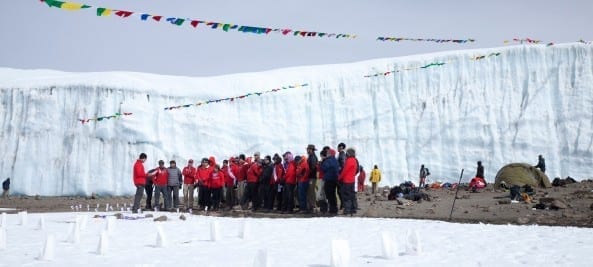
On Jan. 6, 2011, Madonna Nichols began a journey that no one wants to face. She was diagnosed with breast cancer, which dragged her through 20 weeks of chemotherapy, a bilateral masectomy and weeks of radiation.
On Jan. 6 of this year, Nichols found herself on an entirely different yet related journey. She and 18 other cancer survivors, ages 29 to 73, and 21 caregivers were trekking through five ecosystems to the top of Mount Kilimanjaro in Tanzania. Those caregivers included Nichols’ spouse, Jeff Nichols, D.O.’90, and Bradley Hiatt, D.O.’97.
“It was the experience of a lifetime not only from a personal standpoint, but also emotionally, physically and spiritually,” says Hiatt, an oncologist with Medical Oncology and Hematology Associates in Des Moines. “You become so close to people in the group. You share everything – the sickness and the joy.”
The group – which included a priest, a viola player, an Army officer, a cage fighter and an insurance executive – took their journey under the auspices of Above and Beyond Cancer, a nonprofit organization established to reduce the burden of cancer. Last year, the organization took another group of 14 cancer survivors to the base camp of Mount Everest, the world’s tallest peak.

“Above and Beyond Cancer is a transformative experience for the people on the trip as well as for the people at home,” says Richard Deming, M.D., the organization’s founder and chairman and the medical director of Mercy Cancer Center, Des Moines. “We want to raise awareness of what we can do to reduce the incidence of cancer.”
Toward that goal, the Kilimanjaro group, which had the American Cancer Society as its premier sponsor and Mercy Medical Center, Des Moines, as a major supporting sponsor, conducted the highest-altitude Relay for Life in history at the top of the mountain on Jan. 11. Relays for Life are American Cancer Society events in which teams of people walk or run laps to raise awareness and money for cancer research and other related programs. For its Relay, the Kilimanjaro group set out luminaria to spell the word “HOPE,” which they circled for their laps. They also strung up on the mountain’s 150-foot-high glacier of vertical ice 800 prayer flags, each decorated with photographs, drawings and phrases commemorating the lives of cancer survivors or those who had died of the disease.
“That was a very emotional experience,” Madonna Nichols says. “I’m so glad I did this trip. Cancer changes your perspective on things. We bonded as a group and have kept in touch since.”
That 37 of the expedition participants – 17 cancer survivors and 20 caregivers – reached the top of Kilimanjaro, at 19,336 feet the highest peak on the African continent and the tallest free-standing mountain in the world, is nothing short of extraordinary.
“Everyone had issues – nausea, diarrhea and altitude sickness in addition to the patients’ pre-existing conditions,” says Jeff Nichols, an anesthesiologist at Iowa Lutheran Hospital in Des Moines. “Once people found out I am an osteopath, I had a lot of requests [for osteopathic manual treatment]. I did a lot of OMT on the mountain.
“The trip was a metaphor,” he adds. “The patients all climbed their own mountain with their cancer treatments. Now they were standing at the top of a real mountain.”
Nichols credits the group’s success to the expertise of Deming and Charlie Wittmack, executive director of Above and Beyond Cancer who’s reached the summit of Mount Everest twice, in planning such epic expeditions. Deming gives credit to the two DMU alumni.
“There are cancer survivors who wouldn’t have made it to the top of Kilimanjaro without the professional and compassionate care given by Dr. Hiatt and Dr. Nichols,” Deming says. “They represent the best of what doctors are with their wonderful combination of professional skill and kind care given in a healing manner.”


